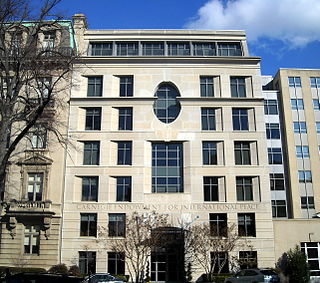
The Carnegie Endowment for International Peace (CEIP) is a nonpartisan international affairs think tank headquartered in Washington D.C. with operations in Europe, South and East Asia, and the Middle East as well as the United States. Founded in 1910 by Andrew Carnegie, the organization describes itself as being dedicated to advancing cooperation between countries, reducing global conflict, and promoting active international engagement by the United States and countries around the world. It is well-funded and characterized by elite leadership drawn from the business community and both major parties.

Washington's Headquarters State Historic Site, also called Hasbrouck House, is located in Newburgh, New York overlooking the Hudson River. George Washington lived there while he was in command of the Continental Army during the final year of the American Revolutionary War; it had the longest tenure as his headquarters of any place he had used.

Massachusetts Avenue is a major diagonal transverse road in Washington, D.C., and the Massachusetts Avenue Historic District is a historic district that includes part of it.

Christ Church, at Zero Garden Street in Cambridge, Massachusetts, U.S., is a parish of the Episcopal Diocese of Massachusetts. Built in 1760–61, it was designated a National Historic Landmark as one of the few buildings unambiguously attributable to Peter Harrison, the first formally trained architect to work in the British colonies.

West Virginia Independence Hall is a historic government building at 1528 Market Street in downtown Wheeling, West Virginia, United States. It was built in 1860 under the supervision of architect Ammi B. Young for the federal government as a custom house, post office and courthouse. It is architecturally significant for its innovative uses of wrought iron as a framing material, and is historically significant for its role in the American Civil War. It housed the Wheeling Convention (1861), as well as the West Virginia Constitutional Convention (1863), which resulted in the separation of Unionist West Virginia from Confederate Virginia. This made it the only state to secede from a Confederate state during the war. The building was originally built as the custom house for the Western District of Virginia, and later became the center of government for the Restored Government of Virginia from 1861 to 1863, with Francis H. Pierpont serving as its governor. It was declared a National Historic Landmark in 1988. The building is now a state-run museum, housing exhibits on West Virginia history.
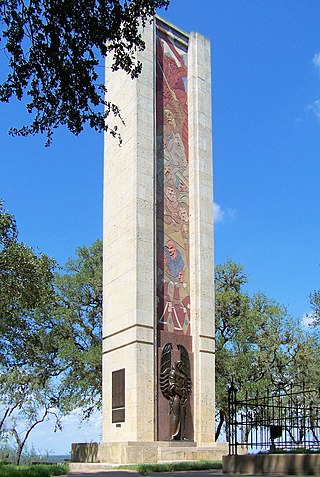
Monument Hill and Kreische Brewery State Historic Sites is a historic state park located at 29.888° -96.876°, just off U.S. Route 77, south of La Grange, Texas. The park sits on a sandstone bluff above the Colorado River. Monument Hill is a crypt and memorial to the men who died in the Dawson Massacre and in the Black Bean Episode of the ill-fated Mier Expedition.

Washington's Headquarters at Valley Forge, also known as the Isaac Potts House, is a historic house that served as General George Washington's headquarters at Valley Forge during the American Revolutionary War. The building, which still stands, is one of the centerpieces of Valley Forge National Historical Park in Southeastern Pennsylvania.
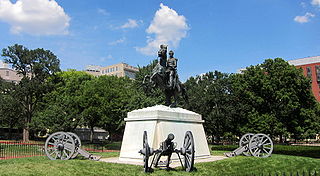
The Lafayette Square Historic District is a National Historic Landmark District in Washington, D.C., encompassing a portion of the original L'Enfant Plan for the city's core. It includes the 7-acre (2.8 ha) Lafayette Square portion of President's Park, all of the buildings facing it except the White House, and the buildings flanking the White House to the east and west. The district was designated a National Historic Landmark in 1970.

The Samuel J. Tilden House is a historic townhouse pair at 14-15 Gramercy Park South in Manhattan, New York City. Built in 1845, it was the home of Samuel J. Tilden (1814–1886), former governor of New York, a fierce opponent of the Tweed Ring and Tammany Hall, and the losing presidential candidate in the disputed 1876 election. Tilden lived in the brownstone from 1860 until his death in 1886. From 1881 to 1884, Calvert Vaux combined it with the row house next door, also built in 1845, to make the building that now stands, which has been described as "the height of Victorian Gothic in residential architecture" with Italian Renaissance style elements. Since 1906 it has been the headquarters of the National Arts Club, a private arts club.

Jackson Place is a Washington, D.C. street located across from the White House and forming the western border of Lafayette Square between Pennsylvania Avenue and H Street, NW, beginning just south of Connecticut Avenue.

The American Peace Society House, also known as the Glover House, is a historic house at 734 Jackson Place NW, facing Lafayette Square in the heart of Washington, D.C. Built in 1878 for banker and philanthropist Charles Carroll Glover, it is most notable as the national headquarters of the American Peace Society from 1911 to 1948. The Peace Society was one of the first overtly pacifist organizations in the nation, with a history dating to 1815. The house was declared a National Historic Landmark in 1974.

The Administration Building, Carnegie Institute of Washington is a Beaux-Arts style building designed by architects Carrere and Hastings, and located at 1530 P Street NW in Washington, D.C. It houses the Carnegie Institution for Science, a philanthropic scientific research organization founded in 1902 by Andrew Carnegie. In recognition of the building's architecture and its unique tenant, the building was declared a National Historic Landmark in 1965. The building was also designated a contributing property to the Sixteenth Street Historic District in 1978.
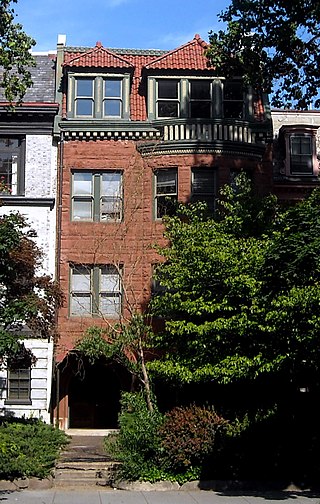
The Robert Simpson Woodward House is a former residence located at 1513 16th Street, NW in the Dupont Circle neighborhood of Washington, D.C. From 1904 until 1914, it was a home of geologist Robert Simpson Woodward (1849–1924), the first president of the Carnegie Institution and a highly regarded scientist and science administrator. The building currently serves as the Capital Research Center headquarters. It was declared a National Historic Landmark in 1976 and designated a contributing property to the Sixteenth Street Historic District in 1978.

The Yard is one of the main quadrangles on the campus of Howard University in Northwest Washington, DC. The Yard is the principal open space at the northern end of the academic portion of the campus, flanked by nine academic buildings. It is the site of a variety of campus gatherings, most notably for its annual Homecoming festivities, known as "Yardfest". The quadrangle and three buildings, Andrew Rankin Memorial Chapel, Frederick Douglass Memorial Hall, and Founders Library, are a listed National Historic Landmark, important for their role in the advancement of civil rights in education during the 20th century.

1 Broadway is a 12-story office building in the Financial District of Manhattan, New York City. It is located at the intersection of Battery Place and Broadway, adjacent to Bowling Green to the east and the Battery to the south.
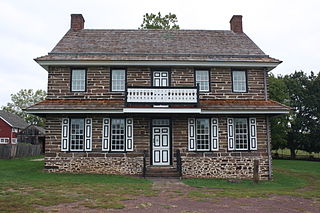
Peter Wentz Farmstead is a historical German American farm which has been continuously farmed since 1744. It is located in Worcester Township, Montgomery County, Pennsylvania near Lansdale.

Blair House, also known as The President's Guest House, is an official residence in Washington, D.C., the capital of the United States. The President's Guest House has been called "the world's most exclusive hotel" because it is primarily used as a state guest house to host visiting dignitaries and other guests of the president. Parts of the historic complex have been used for an official residence since the 1940s.

The Office of Fine Arts (M/FA) is a division of the U.S. Department of State reporting to the Under Secretary of State for Management. The mission of the office is to administer appropriate settings for dialogue between U.S. officials and their international guests, to illustrate the continuity of American diplomacy through relevant objects, and to celebrate American cultural heritage through the acquisition, preservation and display of works of art with people around the world.


























